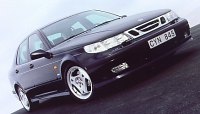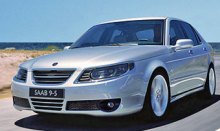|
Saab 9-5
Debut: 1997
Maker: Saab
Predecessor:
9000 |
|
 The
newest Saab 9-5 replaces the 12 years-old 9000 series to target BMW 5
series
and Audi A6. Is it capable enough to beat those brilliant rivals,
particular
the BMW ? In specification, 9-5 is intended to provide 90% the quality
of Mercedes, BMW and Audi, and then undercut them in price. As it is
based
on Opel Vectra's suspensions and Omega's V6 engine (though the entry
level
2.0 and 2.3 litres inline-4 turbo are inhouse-built, which serve 9000
for many years), the new 9-5 is even more cost-effective than its
predecessor
which was famous of platform sharing with Fiat group. The
newest Saab 9-5 replaces the 12 years-old 9000 series to target BMW 5
series
and Audi A6. Is it capable enough to beat those brilliant rivals,
particular
the BMW ? In specification, 9-5 is intended to provide 90% the quality
of Mercedes, BMW and Audi, and then undercut them in price. As it is
based
on Opel Vectra's suspensions and Omega's V6 engine (though the entry
level
2.0 and 2.3 litres inline-4 turbo are inhouse-built, which serve 9000
for many years), the new 9-5 is even more cost-effective than its
predecessor
which was famous of platform sharing with Fiat group.
Like
900, 9-5 is less characterful with those German competitors. However,
its
engines are quite special. Perhaps Saab wants to reminding you that it
was the pioneer of turbocharging technology, all three engines are
fitted
with light-pressure turbocharger, which is a low cost solution for lack
of torque. Look at the 3 litres V6: Peak power 200hp is actually lower
than the normally-aspirated version it based on, but the torque is
28lbft
up and became more accessible at low rpm. Not only flexible,
light-pressure
turbocharging also benefits fuel consumption.
Because
of the superior torque advantage, Saab 9-5 performs strong in normal
road
use. Nevertheless, it has not got the necessary chassis to cope with.
In
terms of handling, it was found to be too nose-heavy, thus generating
considerably
understeering. Steering is as lifeless as typical Japanese cars.
Stability
can never compare with German cars because of excessive body roll, but
this also implying a very comfortable ride is obtained.
When
comes to the cabin, the Saab regain so many scores : spacious,
comfortable
seats, stylish (aero-style) dashboard, nice quality of
material....Unfortunately,
competitions are too strong. I doubt whether 9-5 can steal sales from
BMW
5 series and Audi A6, especially when the A6 is also a bargain.
|
| The
above report was last updated in 1998. All Rights Reserved. |
9-5 Aero
|
 While
the unfavourable experience of 9-3 Viggen is still living in our
memory,
Saab presents us the 9-5 Aero, a high performance 9-5 sharing the
engine
with Viggen. The 2.3-litre turbo four is as explosive as ever, with a
massive
258 lbft of torque starting from 1900rpm. Instead of the younger
brother’s
225hp, it boost 5 more horses, thanks to a more generous engine
management
program. Even so, turbo lag is not noticeble, because the electronic
throttle
will automatically open wider at initial acceleration in order to bring
the turbine to operation earlier. Moreover, the revised software allows
overboost for 20 seconds, lifting the torque output to 273 lbft for
enhanced
overtaking ability. While
the unfavourable experience of 9-3 Viggen is still living in our
memory,
Saab presents us the 9-5 Aero, a high performance 9-5 sharing the
engine
with Viggen. The 2.3-litre turbo four is as explosive as ever, with a
massive
258 lbft of torque starting from 1900rpm. Instead of the younger
brother’s
225hp, it boost 5 more horses, thanks to a more generous engine
management
program. Even so, turbo lag is not noticeble, because the electronic
throttle
will automatically open wider at initial acceleration in order to bring
the turbine to operation earlier. Moreover, the revised software allows
overboost for 20 seconds, lifting the torque output to 273 lbft for
enhanced
overtaking ability.
Performance
is no less impressive than the 9-3 Viggen, despite of the heavier body.
Saab claims a 150mph top speed and 6.7 sec to 60mph, which is easily
believable.
Although the power still transfer to the front wheels, the 9-5 Aero
handles
a lot better than the 9-3 Viggen. While the Viggen upset its driver
with
torque steer, scare him with wheel spin and discomfort him with
rock-stiff
ride, the Aero avoided all such trouble. Torque steer does not exist
except
under the hardest acceleration. It should be noted that the basis of
the
Aero, that is, the 9-5, has a much modern chassis than the 9-3. Its
superior
torsional rigidity, advancer suspension design and its wider body
benefits
handling a lot without needing to stiffen the suspension too much.
Wheel
spin is taken care by the addition of traction control (why not in the
9-3 ? perhaps Saab should rethink about it), also helped by the heavier
body. In short, the 9-5 Aero provides a smooth and mature driving
experience
that the Viggen couldn’t hope for.
It
is not to say the Aero is the best sports saloon. Its straight four,
despite
of twin balance shafts, does not rev as smooth as a six at higher rpm.
Sound quality is also inferior. The suspension setting is bias towards
ride comfort rather than handling, so body roll is not as well checked
as the German opponents. Moreover, as a front-wheel drive, you can’t
enjoy
power oversteer, although understeer is not an apparent issue in the
car.
Anyway, for those who want more performance without sacrificing
comfort,
this is the car you must seriously consider.
To
make the Aero, Saab has lowered the 9-5’s ride height by 10mm,
stiffened
its spring and dampers, installed aero skirts and 225/45 ZR 17 tyres
....
everything just predictable. What unpredictable is the pricing : in UK
it is 10% cheaper than the smaller and far worst 9-3 Viggen. Saab’s
engineers
proved that they don’t need TWR to teach them how to tune a high
performance
sedan. Do it in Sweden and save money. |
| The
above report was last updated on 2 Nov 99. All
Rights Reserved. |
Late-2001 facelift
|

Although
I always like the characterful Saab 9-5, writing about any facelift is
unlikely to be very enjoyable. Basically, this is a lists of minor
changes
that won't raise your curiosity:
- Body:
restyled grille, lamps and bumpers inject more elegance to the
distinctive
shape. Front structure is stiffer now.
- Suspensions:
around 10% stiffer spring rate and 1mm thicker anti-roll bars
throughout
the whole range to deliver sharper handling, and surprisingly, with
little
price to pay in the ride department. Of course, it is still far from
the
standard set by BMW 5-series.
- Petrol
engines: much the same as before, but Aero's 2.3-litre four has been
reprogrammed
to produce another 20 horsepower (now 250hp). Sadly, it is no longer
lag-free
as a result. Torque steer is also easier to induce. I'd rather have the
old engine unchanged.
- Diesel
engines: a new Isuzu V6 is added through the relationship with parent
company
GM. 3-litres, all-alloy, 24-valves, common-rail injection, variable
geometry
turbo ... all seemed sophisticated, but it output just 176 horsepower
and
258 lbft of torque, inferior to BMW 530d's 184hp / 288 lbft. Refinement
is good by Isuzu standard but bad for exec cars, with too much
vibration
and noise. However, performance and fuel consumption are good.
- Transmission:
new 5-speed automatic replaces 4-speed. Still lack of Tiptronic gadget.
|
| The
above report was last updated on 27 Nov
2001. All Rights Reserved. |
2005 facelift
|
 Saab
9-5
would have been renewed if GM did not pull out from the premium
platform program co-developed with Alfa Romeo 159. Today, the 9-5 is
already 7 years old, but Saab still needs it to soldier on for 3 more
years until the replacement come - that will be based on the next
Opel Vectra platform. Therefore Saab has introduced another facelift
to the car. Saab
9-5
would have been renewed if GM did not pull out from the premium
platform program co-developed with Alfa Romeo 159. Today, the 9-5 is
already 7 years old, but Saab still needs it to soldier on for 3 more
years until the replacement come - that will be based on the next
Opel Vectra platform. Therefore Saab has introduced another facelift
to the car.
Externally,
the facelift brought 9-5 a new mask - Spiderman-like. Underneath the
skin remains the same chassis. The long-serving turbocharged
2.0-litre and 2.3-litre four-cylinder continues to power the 9-5.
However, the latter now has 3 state of tune: 185 hp, 220 hp and, for
the performance flagship Aero, 260 hp. If you compare with the old
Aero, you will find it has gained 10 horsepower, thanks to improved
intake. Torque output remains unchanged at 258 lbft, so does the
overboost function, which can crank out 273 lbft for at most 20
seconds. Saab claims 155 mph top speed and 0-60 mph can be done in
6.6 seconds, representing a reduction of 0.1 second from the old car,
which is hard to detect. However, the high boost 2.3 engine is always
a strong powerplant, with abundance of punch once you overcome the
slight initial turbo lag. If you want smoother power delivery, I
suspect the 220 hp light-pressure version could be a better choice.
Its 146 mph top speed and 7.4 seconds 0-60 mph acceleration are also
highly respectable.
Refinement-wise,
the straight-four engines cannot match a six-cylinder engine of course.
Saab has added a 2.8 turbo V6 to the 9-3 recently, but it won't be
applied to the 9-5 because the re-engineering cost could not be
recovered in its remaining life. So an interesting scene occurs: the
lower class car gets a V6 while the upper class car gets 4-cylinder
engines only. Nevertheless, the fans of Saab may be glad that the 9-5
is powered by a Swedish-built engine in the traditional 4-cylinder
turbocharged format.
The
suspensions have been retuned with stiffer dampers, bushings and
anti-roll bars but softer rear springs for regular models. The Aero
has 10 percent stiffer dampers and, as before, rides 10 mm lower than
regular models. However, Saab knows very well that the outdated
chassis of 9-5 can never match German premium cars in dynamics, so
they retain the comfort-biased character of the suspensions. The
revised 9-5 actually rides smoother and quieter than before, making
it a good companion for long-distance travel. What a pity at high
speed cruising the pronounced wind noise started showing its age.
Also
showing its age is the cabin. While ergonomics is still excellent,
quality is not. You will be disappointed with its hard plastics and
wide panel gaps.
Handling
is still a weak point of 9-5. It might be a little better than
before, but cannot catch up with the progress of its rivals. The
problem mainly lies in body roll (which it has a lot), agility (which
it lacks) and torque steer which associates with the most powerful
Aero. It's way better than the 9-3 Viggen era, but these days our
standard has raised and we can no longer tolerate torque steer in a
premium executive car.
Outdated
it may be, the 9-5 is still loyal to the traditional character of
Saab – fast, comfortable, practical and affordable. It remains a
true Saab, and, ironically, probably the last true Saab. It deserves a
space for
survival. |
| The
above report was last updated on 24 Oct
2005. All Rights Reserved. |
|
|